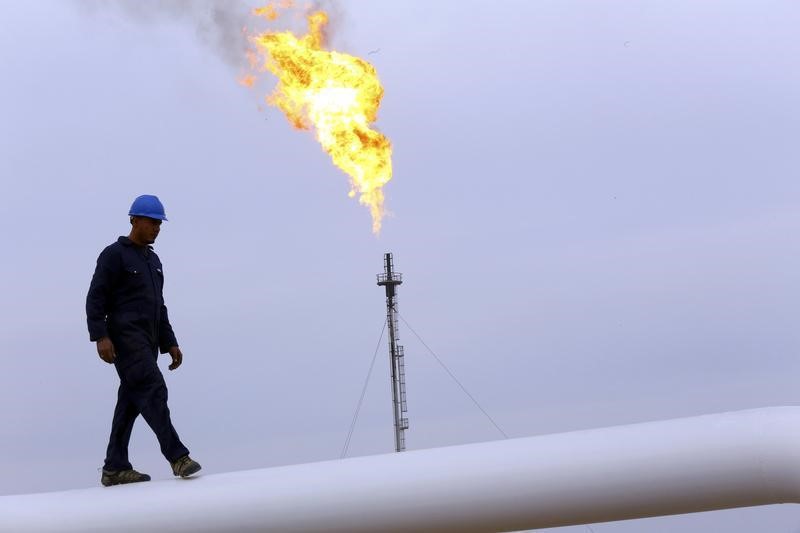By Barani Krishnan
Investing.com -- For a second time in two weeks, crude prices broke below $100 a barrel on Monday.
And despite the volatility inherent from Russian sanctions and OPEC controls, fears of a Covid 2.0 in China and a Federal Reserve bent on doubling down on U.S. rate hikes could make a climb back to this year’s highs of almost $140 a little more difficult.
Brent crude, the London-traded global benchmark for oil, settled down $4.33, or 4.1%, at $102.32 per barrel on Monday, after an intraday low at $99.26. The drop came on top of last week’s slide of 4.5% in Brent.
Unless it doesn't lose anymore from here, Brent could end April in the red. That would be its first negative month since this year’s phenomenal oil rally that sent the benchmark to as high as $139.15 on March 7, two weeks after the invasion of Ukraine that led to swift Western sanctions on Russia that further squeezed the global supply of oil.
West Texas Intermediate, or WTI, the New York-traded benchmark for U.S. crude, settled down $3.53, or 3.5%, at $98.54. Like Brent, WTI fell 4.5% last week, showing a month-to-date loss of 4%. WTI shot to as high as $130.50 on March 7.
A fresh outbreak of Covid cases in Chinese capital Beijing dominated headlines on the pandemic after 47 cases found since Friday in the Chinese capital sparked the testing of millions of people for the virus, in a move that shut down residential and business districts.
Shanghai, which has been locked down for more than two weeks, reported more than 19,000 new infections and 51 deaths in the latest 24-hour period, pushing its death toll from the ongoing outbreak to more than 100.
Anxious to avoid the shortages that hit Shanghai in recent weeks, Beijing’s more than 21 million residents have begun to stock up on food, media coverage showed. Long lines formed in supermarkets as shoppers purchased rice, noodles, vegetables and other food items, while store workers hastily restocked some empty shelves. State media issued reports saying supplies remained plentiful in Beijing despite the buying surge.
Up until two weeks ago, the West’s sanctions on Russian oil — and a potential EU ban to follow as proof of the US-Europe-Canada alliance against Moscow’s invasion of Ukraine — had been the single biggest factor in oil.
While that essentially hasn’t changed, a China Covid 2.0 situation is introducing a different dynamic to oil due to reduced mobility in the world’s largest importer of the commodity.
This is despite the scorn of many energy traders at China’s over-exuberance — some call it a PR exercise — on Covid lockdowns now when the rest of the world has moved on from measures adopted at the height of the pandemic over the past two years.
“The difference here is that China is the world’s second-largest economy and has shown no signs it intends to live with the virus,” said Jeffrey Halley, who heads Asia Pacific and Australian research for online trading platform OANDA.
“It would be a brave man that bets on President Xi Jinping backtracking on anything he says he is going to do, or on the government in general. With that in mind, the likely pressure valve is going to be disruption to China’s export machine, and a cratering of consumer confidence.”
Besides China, the United States appears to be having a mini Covid resurgence too, with a rise lately in cases of the BA.2 variant, and two new sub-variants — called BA.2.12 and BA.2.12.1 — that appear to be even more infectious.
The U.S. is averaging 46,925 cases a day, according to a New York Times tracker, up 51% from two weeks ago.
Hospitalizations, which had also been steadily declining, are also ticking up. The country is averaging 15,642 hospitalizations a day, up 4% from two weeks ago, but still close to the lowest since the first weeks of the pandemic.
On top of Covid fears, the dollar’s rally is also weighing on prices of commodities denominated in the currency, including oil.
The Dollar Index, which pits the U.S. currency against six major rivals, hit a 25-month high of 101.745 on Monday on expectations the Federal Reserve would adopt a 50 basis point, or half percentage point, hike at its May policy meeting next week. That would be double the 25 bps, or quarter point, it approved in March for the first pandemic-era U.S. rate increase.
The dollar would be the chief beneficiary in a rate hike and the economy could be the victim.
The U.S. economy and its labor market have outperformed since the worst of the Covid disruptions of 2020, with GDP growth at 5.7% last year, the best in 40 years, and peak pandemic unemployment of almost 14.8% down to 3.6% by March. But inflation has also picked up beyond expectations, also expanding at its fastest in four decades.
Aggressive Fed actions to control inflation have sparked concerns that the United States could run into recession. A succession of Fed speakers has, however, soothed some market worries over the past week that the economy could turn negative from the central bank’s inflation fight. Optimism, especially over the sterling labor market, has won over some pessimists. But fears of a hard landing for the economy have not entirely evaporated.
